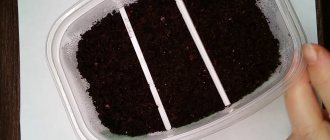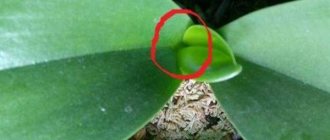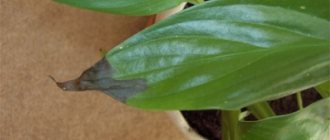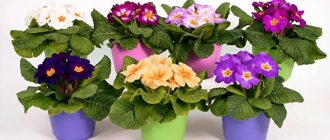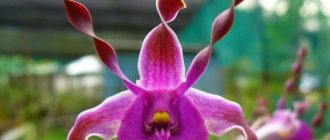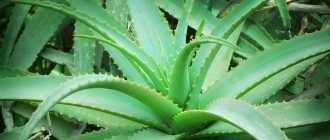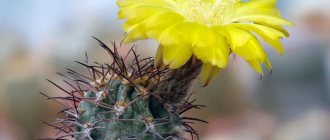The popularity of mimosa is that the process of its flowering begins immediately after the end of winter and ends almost at the very beginning of spring, which is why mimosa is considered to be a “harbinger of spring” in many countries.
Mimosa is a genus of flowering plants from the legume family. The most famous in the world is the bashful mimosa, but in Russia mimosa is mistakenly called a completely different plant - silver acacia or white acacia, which is part of the genus Acaciaceae of the same family.
Below, when describing how to grow mimosa at home, silver acacia will also be included.
Description of mimosa bush
Despite the variety of plant varieties, there is a general description that unites them:
- The crown consists of brown shoots with small cracks.
- The plant has a thorny trunk and small dissected leaves.
- Depending on the growing region, the first mimosa flowers may appear in mid-January.
- Mimosa flowers look like fluffy yellow balls.
Flowering can cause inconvenience to allergy sufferers; you should be aware of this and do not grow such a plant at home.
Useful properties of the plant
Mimosa leaves are of particular value in folk medicine. The tincture helps in the treatment of sore throats, wounds and cuts. The roots of the plant are used for dysentery and toothache. A decoction of mimosa roots is used as an antipyretic.
In addition, the plant has antiseptic, anti-inflammatory, astringent and healing properties. Mimosa contains various beneficial substances: the alkaloid mimosine, tannin, calcium oxalate.
Due to its many medicinal properties, the plant is used to reduce bleeding from cuts, cracks, and hemorrhoids. Mimosa pudica is used medicinally for burns and has a regenerating effect on the skin. It is actively used for cosmetic purposes. Creams and masks based on mimosa leaves are used for sensitive facial skin. The skin becomes soft, beautiful and soft.
Basic rules for growing mimosa
The table provides brief rules for caring for mimosa at home.
| Lighting level | Bright, diffused light is preferred. |
| Content temperature | Moderate from March to September (up to +24 degrees), in winter a little lower - up to +18 degrees. |
| Watering mode | In spring and summer, you need to water the plant often; in the cold season, the rate is reduced. |
| Air humidity | The humidity level should be high. It is recommended to spray the flower every day with moderately warm water or keep the flower on a tray with wet expanded clay. |
| The soil | The soil includes equal shares of peat, turf, sand and humus. |
| Feeding | Carry out twice a month, but only during the growing season. The dosage of mineral fertilizers should be half the amount indicated on the pack. |
| Transfer | This is done only when necessary, because mimosa is usually grown as an annual. It is best to replant it in the spring, at the beginning of the growth phase. |
| Trimming | The flower does not need regular pruning of leaves. |
| Bloom | The flowering period lasts from spring to the end of August. |
| Rest period | The rest period is conditional; in winter it simply slows down its growth rate slightly. |
| Reproduction | Seed. Many species can also be propagated by cuttings; this method is usually used in greenhouse cultivation. |
| Pests | Aphids and spider mites. |
| Diseases | Stretching or yellowing of foliage is usually caused by lack of care or unfavorable environmental factors. |
Temperature
Silver acacia in a pot is the dream of any indoor plant lover. She is unpretentious, indifferent to air humidity, and not too spoiled by strict temperature conditions. In summer, the plant will feel amazing on the balcony, as it loves fresh air and a warm breeze. The most optimal air temperature is from 24 to 27 degrees.
Winter is the time for mimosa to bloom. The plant will grow well at normal room temperature. The main thing is that the air is warmed up by at least 12 degrees. Otherwise, the tree will stop its development and will not bloom.
Agricultural technology for growing mimosa on a personal plot
- Selecting a landing location. Since the plant is still a “resident” of tropical areas, it is problematic to grow it in our climate zone; for this purpose, mimosa is kept in rooms or greenhouses, greenhouses or winter gardens. Otherwise, the plant is grown as an annual, since by the autumn days the shoots become very elongated and the bush loses its attractiveness, but it is easy to renew it from seeds. If you are in a climate where winters are mild, then you should choose a place in a sunlit area - in the south, southeast, southwest, east or west. All this is because in shading, silver acacia will lose its decorative appearance, and you may not wait for flowering. And only in the presence of bright solar insolation is a mimosa able to form a compact bush or bloom profusely. The landing site must be protected from the wind. However, if the plant is immediately planted on the south side, sunburn may occur on the leaf blades. Therefore, at first, until adaptation takes place, a little shading is carried out. For mimosa, slow development and a slow set of height parameters are noted.
- Temperatures when growing mimosa in winter should not fall below 10 degrees below zero.
- The soil for planting mimosa is selected taking into account its natural “predilections”. The optimal composition of the substrate is a composition of the top soil layer (turf), peat, river sand and prepared humus. All parts of the components are equal. It is recommended to lay a layer of middle fraction expanded clay at the bottom of the hole - this will protect the root system from waterlogging. If the plant is grown as a perennial, it will need replanting in the spring. It is recommended to periodically loosen the soil and remove weeds.
- Watering. Growing mimosa requires normal conditions of humidity and watering; naturally, in natural conditions, the weather decides everything. However, if the summer is very hot, you will sometimes have to water the silver acacia, although the plant is drought-resistant. It is advisable to use collected rain or river water, but if this is not available, then tap water is passed through a filter, boiled and allowed to settle for a while. Then the water from the container is carefully drained so as not to capture sediment. Watering at first is necessary until complete rooting, when the plant has just been transplanted.
- Fertilizing the substrate. For mimosa, it is recommended to fertilize in the spring and summer, when the process of active vegetation and flowering is underway. You can use complete mineral complexes dissolved in water for irrigation twice a month, and when flowers appear, use preparations for beautifully flowering plants.
- General care for mimosa is not difficult, since you don’t even have to mold the plant’s crown. However, if silver acacia is used as a perennial, it is recommended to cut off shoots of the plant that are too elongated. If there is enough light, mimosa will quickly make up for their loss.
Acacia cuttings
The apical stem cuttings are cut after flowering or at the end of summer. Shoots removed during pruning are excellent for propagation. The optimal length of prepared cuttings is 10 cm. Before planting, they are stimulated in a solution of Epin or any other similar preparation for 6-8 hours.
We suggest you read: At what temperature should potatoes be stored?
It is very effective to use small mini-greenhouses for rooting. If the cuttings are planted in separate containers, then they are covered with a glass jar or plastic wrap. Such structures will create a constant humid and warm microclimate, facilitating faster rooting of the cuttings. You can use universal soil, purchased in a store, adding a small amount of river sand.
Caring for mimosa at home
Lighting
Mimosa growing in a pot requires a lot of sunlight. At the same time, the plant is not afraid of direct rays; it only needs to be shaded during particularly hot hours or use a diffusing screen. This allows you to keep a pot of mimosa on the southern windows, but western and eastern directions are also suitable for it. At the same time, a sudden change of environment to a sunny one can harm an unprepared mimosa. When moving a flower into the light from a shady place or after a long period of cloudy weather, it is shaded for some time to avoid sunburn, gradually accustoming it to more intense lighting.
In the shade, mimosa loses its decorative effect, its leaves begin to turn pale and grow old, and you can’t wait for flowering at all. At the same time, the plant does not like artificial lighting.
Temperature
From March until the onset of autumn cold, mimosa is kept in a room with a temperature of no more than +25 degrees. The plant does not like heat. In winter, relative coolness will be optimal - from +15 to +18 degrees.
Watering mode
You can water mimosa only with well-settled water. This is done as the top soil layer dries. In summer, the flower is watered very abundantly, but in winter the volume of watering is reduced. Stagnation of water at the roots in a cool room can lead to the development of diseases. But overdrying the earthen clod is considered no less harmful. You should try to keep the soil slightly moist at all times.
Humidity level
For full growth, mimosa requires high humidity. Every day it needs to be sprayed with sufficiently warm, settled water or a sprinkling procedure must be carried out. A tray filled with wet pebbles (expanded clay) will help to additionally humidify the air around the plant. You can use wet peat. At the same time, the bottom of the pot should remain dry so as not to over-moisten the soil ball.
Feeding
Fertilizing mimosa is only permissible in spring and summer. To do this, twice a month a universal solution of minerals intended for flowering plants is added to the ground. But the dosage indicated on the pack should be halved, otherwise there is a risk of burning the roots of the flower. In autumn and winter, when mimosa is resting, no fertilizing is applied.
Features of transplantation
Annual mimosa usually does not need replanting, but they also try to replant perennial mimosa as rarely as possible. If necessary, this procedure is carried out in the spring, after the start of the growth period, transferring the entire earthen ball into a new container. Its dimensions should not differ significantly from the old one. Drainage is placed at the bottom of the pot, and a mixture of peat with sand, turf and leaf soil is used as soil. In this case, it is recommended to remove and change only the top layer of old soil, being careful not to touch the roots. The underground part of the mimosa does not like contact, so if possible they try not to touch the root system and, especially, not to cut it.
Trimming
Even when grown at home, mimosa is usually considered an annual. By autumn, its shoots begin to stretch out greatly and lose their decorative effect. In order for the flower to please the eye longer, you will have to trim the elongated stems annually. If you then keep the pot in the light, the plant will quickly grow fresh shoots.
Pruning can be done after flowering, but it is best to do it in the spring. This method allows you to assess the degree of growth of old stems and the best way to form a bush. Small pinching of young shoots can be carried out throughout the year.
From time to time, perennial mimosa should undergo not only formative, but also sanitary pruning. Drying twigs and broken leaves need to be quickly cut off so that their drying does not lead to the shedding of neighboring ones.
Virulence
Mimosa pollen is a very strong allergen. That is why people with pollen allergies are not recommended to keep such a flower in the house. You should also promptly clean the pot of mimosa from fallen inflorescences or leaves.
Reproduction
You can sow seeds in universal purchased soil. You should not plant in garden soil, as it may contain seedlings of various microbes.
- The container is suitable for small sizes, but it must have a drainage layer.
- First put the expanded clay in the pot, and only then the soil.
- The substrate must be well moistened and seeds should be placed on its surface, sprinkled with soil no more than 1 cm.
- The pot needs to be covered with film and placed in a warm room or greenhouse.
The temperature required for seeds varies from 25 to 30 degrees. You also need to monitor the humidity.
It is necessary to ventilate the container periodically by removing the film from it. Don't forget to water the seeds using a spray bottle.
The emerging sprouts are transplanted into separate pots and placed on a windowsill with good lighting, but not with piercing sun.
After the third leaf appears on the sprouts, it must be transplanted into a pot with the same soil that is used for planting adult plants. When picking mimosa, be extremely careful, as its roots are very delicate and can be easily damaged.
Cuttings at home
A method that is used much less frequently because it is ineffective. The fact is that rooting cuttings is quite difficult. In order for them to take root, you need to place the shoot in water or in a mixture of peat and sand.
Gift for March 8
If you want to surprise your colleagues or friends and give them a pleasant surprise, you can grow this plant in individual pots. Seeds are sold in almost all flower shops. They are quite large, so it is convenient to work with them. Now you need a pot. A plastic cake tin is ideal. It is equipped with a lid, so it makes an excellent greenhouse.
Using an awl, we make holes, add drainage and lay the soil. Now spray the greenhouse with water and it is ready for planting. Cover with a lid and put in a warm place. The seeds do not need light, so it is not necessary to keep it on the window. Don't forget to check and spray with water as it dries.
You don't have to wait long, the germination of the seeds is very good. As soon as the seedlings get a little stronger, they can be planted in different pots. Consider the fact that the plant alone will not look very aesthetically pleasing. This is a thin stem with equally fragile branches. Therefore, feel free to plant 6-9 pieces in one pot. Then the bush will be lush. If you guess when mimosa blooms, you can give a bright bush right for the holiday.
Pests and diseases
Of the pests, mimosa is most often attacked by spider mites and aphids. They damage the leaves of the plant; you can get rid of them by washing the leaves with a weak soap solution, which you simply need to wash off, or by treating the bush with special insecticides.
Mimosa diseases are usually associated with improper conditions or care:
- if the leaves of the plant are often rolled up, then the room is either smoky or there are odors coming from the kitchen;
- limp and yellowed leaves indicate a lack of moisture;
- non-opening leaves indicate either non-compliance with the temperature or an excess of moisture;
- elongated leaves and shoots indicate a lack of light;
- If mimosa does not begin to bloom, you need to increase the temperature in the room.
It is important to periodically inspect the plant, immediately eliminating the causes of its ill health.
It is recommended to spray with insecticidal preparations, with repeated treatment after a week. If there is not enough moisture for the mimosa, the leaf blades turn yellow and wither. If watering is also carried out irregularly, the leaves will begin to fall off. When the weather is quite rainy, the silver acacia will not open its leaves during the day and will begin to turn yellow. When planting mimosa in a very shady place, its shoots will become very elongated, and in such places with low light levels it will be difficult to wait for flowering. Also, mimosa will not bloom if the temperature is lower than required.
You may also find the following materials useful:
- How to properly grow asters with seeds and seedlings
- Beautiful ball rose scrub: nuances of planting and caring for a flowering shrub
- Exquisite and unpretentious scrub roses: the best varieties and types
- How to care for roses to ensure lush flowering
- 12 reasons why tulips don't bloom and how to fix it

